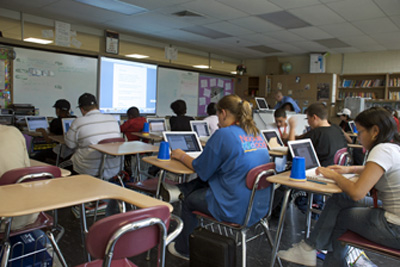 by W. Ian O'Byrne
by W. Ian O'Byrne
Many of our school districts are moving to one-to-one computing initiatives. These may take the form of wired desktop computers, laptops and netbooks, or tablet computers. For some guidance as to best practices in going one-to-one, please review this Center for Digital Education handbook and this Journal of Technology, Learning and Assessment article. A growing contingent of schools is moving to a "bring your own device" (BYOD) policy. For more insight into BYOD policies, please review this whitepaper from MicroSoft and this post from The Innovative Educator blog.
Despite the need to provide our students with ubiquitous access to the Internet and other communication technologies (ICT), there are classrooms that do not, or cannot, provide sufficient access. In working with pre-service and veteran educators, I find that at times there is a belief that because they do not have technological access in their classroom, they are exempt from discussions about the use of new and digital literacies. In these instances, I suggest that it requires teachers to be a bit more creative in planning and development of lessons…qualities that teachers usually "have in spades."
In the event that you do not teach in a one-to-one environment, there is a multitude of ways that you can build the knowledge, skills, and dispositions students will need when they do have access to ICTs. One way to incorporate online texts into the classroom is to print out and photocopy websites and blogs, and have students read them along with other print sources (e.g., textbooks, novels, poems, biographies, newspapers). A second way to bring online multimodal information sources is to capture them and bring these images or videos into the classroom. I use products like Jing, Skitch, and Evernote daily to capture and create "paper copies" of websites and videos to share with students in class. A final way to build these aptitudes when all students don't have online access is to have students blog without using the Internet. As a classroom teacher, I started every class with journal time. This process included the traditional spiral bound notebook that remained in the classroom. When we did have access to the computer lab or laptop cart, students were to select their favorite journal entry from the past week and rewrite it on their blog.
These three examples identify ways that we can think creatively about using online informational texts in our classroom when we are not able to work online. One-to-one computing and BYOD initiatives are great, but not all classrooms and schools can afford to participate. Regardless of your ability to provide each one of your students a seat on the information superhighway, teaching and learning needs to focus on the individual student learning objectives. After that you can figure out creative ways to effectively and authentically embed technology into your classroom.

W. Ian O'Byrne is an assistant professor in the Department of Education at the University of New Haven. You can follow him on Twitter (@wiobyrne), at Google+, or contact him at wiobyrne@gmail.com.